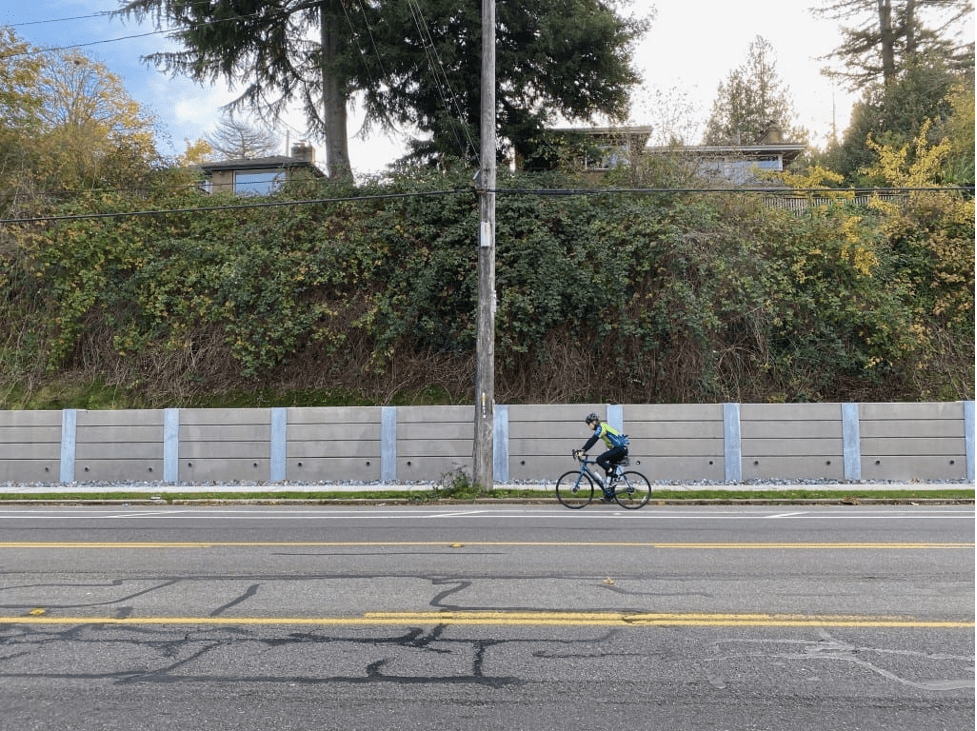 This retaining wall on Rainier Ave S helped prevent a landslide from reaching the sidewalks or street! Photo Credit: SDOT.
This retaining wall on Rainier Ave S helped prevent a landslide from reaching the sidewalks or street! Photo Credit: SDOT. Summary
In this SDOT’s Best of the Month, we’ll highlight (non-West Seattle Bridge!) projects that made news – and some that didn’t.
- We created a new COVID-19 Transportation Response, Reopening, and Recovery page on our website so that you can see how we’re working to keep Seattle safe and moving.
- We’re keeping people safe when winter weather hits. From rapid response to windstorms, to installing retaining walls to prevent landslides. If inclement weather causes problems, our crews work to fix them quickly.
- In case you missed it, we talked a lot about how we’re making our streets safer for people walking and rolling while balancing the needs of all modes of travel.
Our crews work around the clock, around the city, to keep you moving safely. Here are a few big accomplishments that didn’t make it into our blog this month.
NEW COVID-19 Transportation Response, Reopening, and Recovery webpage so you can see how we’re meeting the moment to keep you safe and moving throughout the pandemic.

As our city moves through and recovers from an unprecedented global pandemic, we’re working hard to understand how your travel and mobility have been impacted. Our new COVID-19 Transportation Response, Reopening, & Recovery webpage outlines how COVID-19 is impacting different communities in our region, how we’re working to support people and neighborhoods citywide, and what we’re prioritizing moving forward to equitably recover and reimagine Seattle.
In response and recovery, we’re prioritizing:
- Combating the disproportionate impacts of the virus on communities of color
- Centering equity in neighborhoods disadvantaged by a long history of structural racism
- Increasing public space to meet physical distancing needs
- Supporting our businesses and their employees
Some of our important initiatives to-date include increasing active transportation options through Stay Healthy and Keep Moving Streets, rethinking how we use curb space and free permits to support our vital small businesses and restaurants, and making micromobility (yay, scooter share!) a more attractive and accessible option.
It’s winter and we – along with our retaining walls and other important infrastructure – are working around the clock to keep you safe and moving when winter weather hits.
Recently, after a powerful windstorm in mid-January, our signal crews responded quickly to keep us safe on the road.
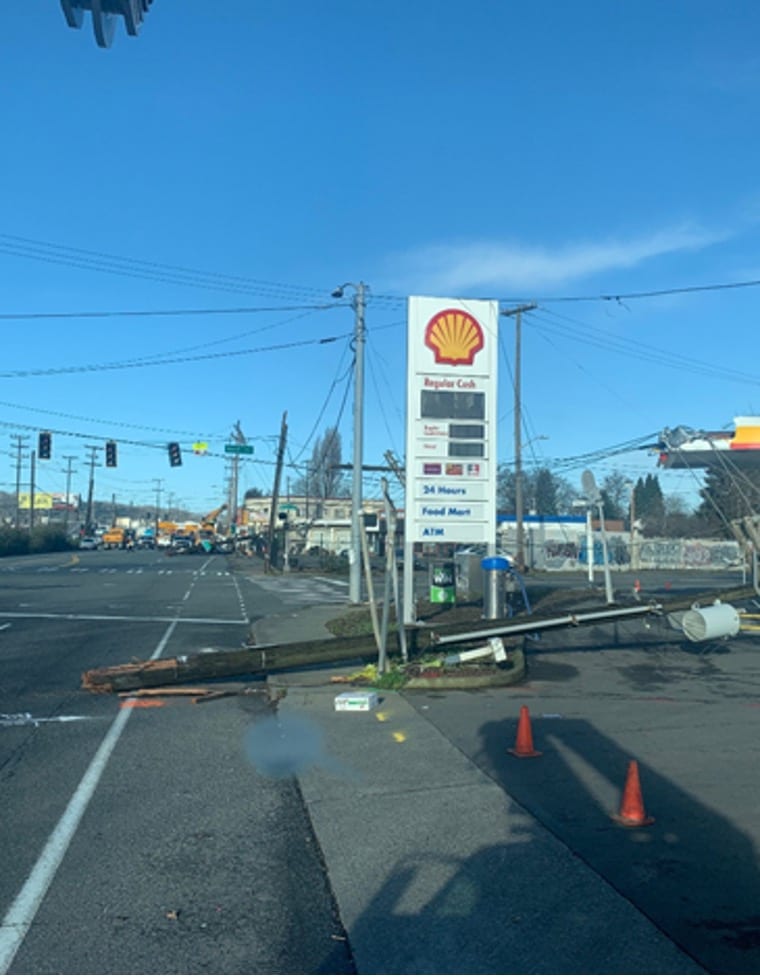
Downed light poles on East Marginal Way. Photo Credit: SDOT. 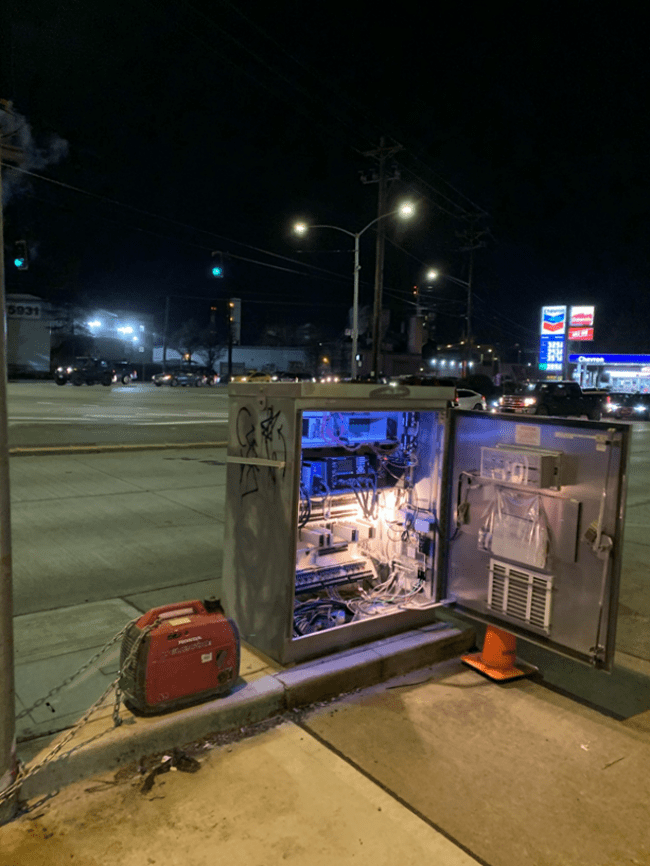
Signal controller cabinets. Photo Credit: SDOT.
The recent windstorm caused lots of power outages around Seattle. In fact, at one point there were over 500,000 without power across the Puget Sound region. Our Transportation Operation Division signal crews responded quickly to keep signals on and help people travel safely and predictably despite the windstorm.
On East Marginal Way, several Seattle City Light primary poles came down, causing outages along the Michigan St and East Marginal Way corridors. These are absolutely critical detour routes for both people and freight during the long-term closure of the West Seattle High-Rise Bridge.
Signal crews responded to dark intersection calls around 9 PM and found that five critical signals were affected by the outage. They put out generators to keep traffic from the 1st Ave S bridge and on Airport Way S flowing.
Three signals on Michigan St were also affected but were able to continue operating, thanks to new upgrades through the Michigan Street Intelligent Transportation Systems (ITS) project. As part of the project, uninterruptible power supplies (UPS) were installed with the new signal controller cabinets. Since we have limited resources for generator support during widespread outages, these upgrades are crucial for keeping traffic moving. Because of this upgrade, the intersections at 4th Ave S, 6th Ave S, and Corson Ave S were able to continue to function without generators or personnel support for the majority of the outage.
We build and maintain retaining walls and stormwater infrastructure so our city is prepared for heavy rains.
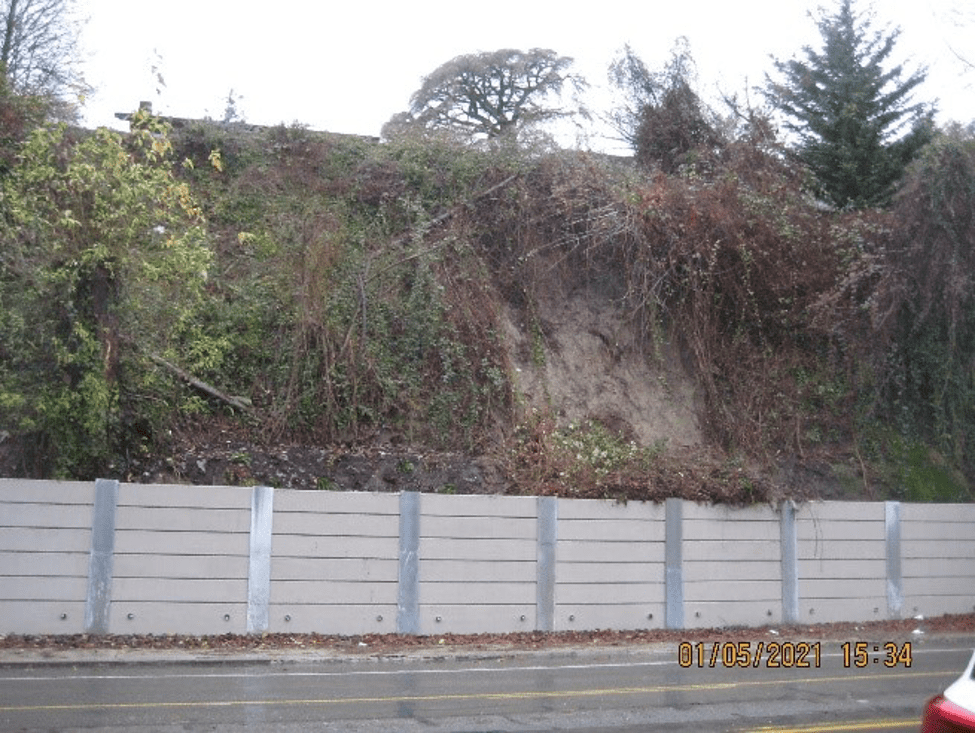
Seattle’s wet winters, steep hills, and geology is prone to frequent landslides in the winter and early spring. Over the years, these landslides have encroached onto sidewalks and bike and vehicle lanes. In 2020, we installed or replaced eight retaining walls – called Soldier Pile Walls, Ecology (Eco) Block Walls, and Rock Walls – along Rainer Ave S on the 9500 to 10400 block. In January, a landslide occurred from a steep slope where one of these soldier pile walls were built. Thanks to the wall, the sidewalk and street were not impacted by the landslide.
When inclement weather does cause slides, we can count on our Roadway Structures team to respond!
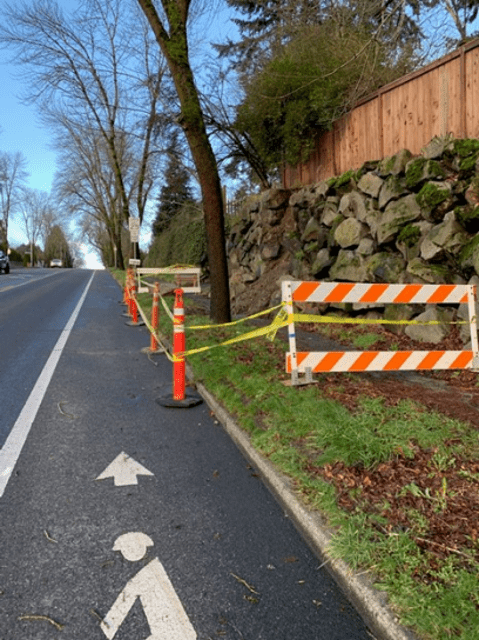
Collapsed rock wall. Photo Credit: SDOT. 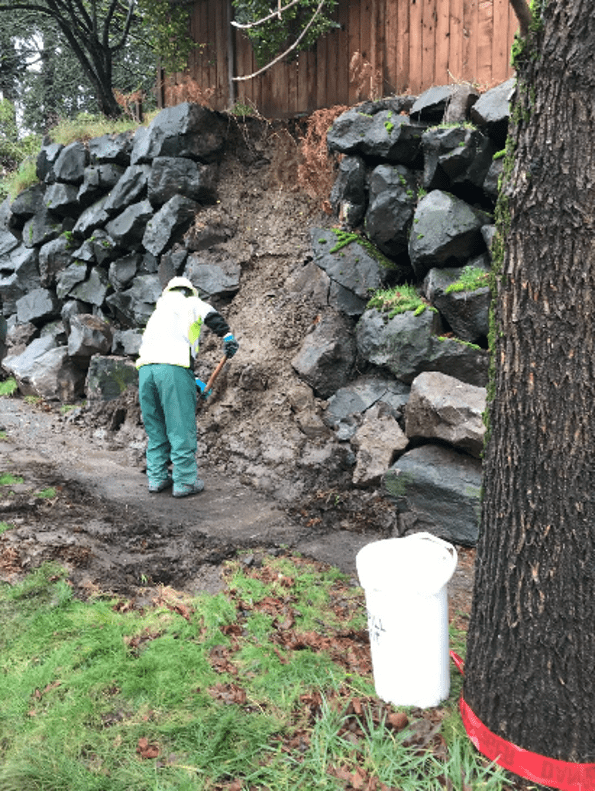
SDOT crew member removing debris from the sidewalk. Photo Credit: SDOT.
After heavy wind and rain on January 12, a rock retaining wall slid onto a sidewalk, blocking the right of way and endangering the public. When the report came in that a rock wall had collapsed, our Roadway Structures team sprang into action, dispatched crews to gather their equipment, and headed to the site. Upon arrival, our crews discovered that the rock wall was dangerously close to a bus stop, so they immediately called for a sidewalk closure and relocation of the stop. Crews provided the public with a safe alternate route to make their way through the area.
Our crew cleared away the fallen rocks and soil and worked together to carry out this dangerous task safely. We are grateful for the experience and expertise that they bring to each emergency situation!
In case you missed it: We’re making our streets safer for people walking and rolling while balancing the needs of all travel modes.
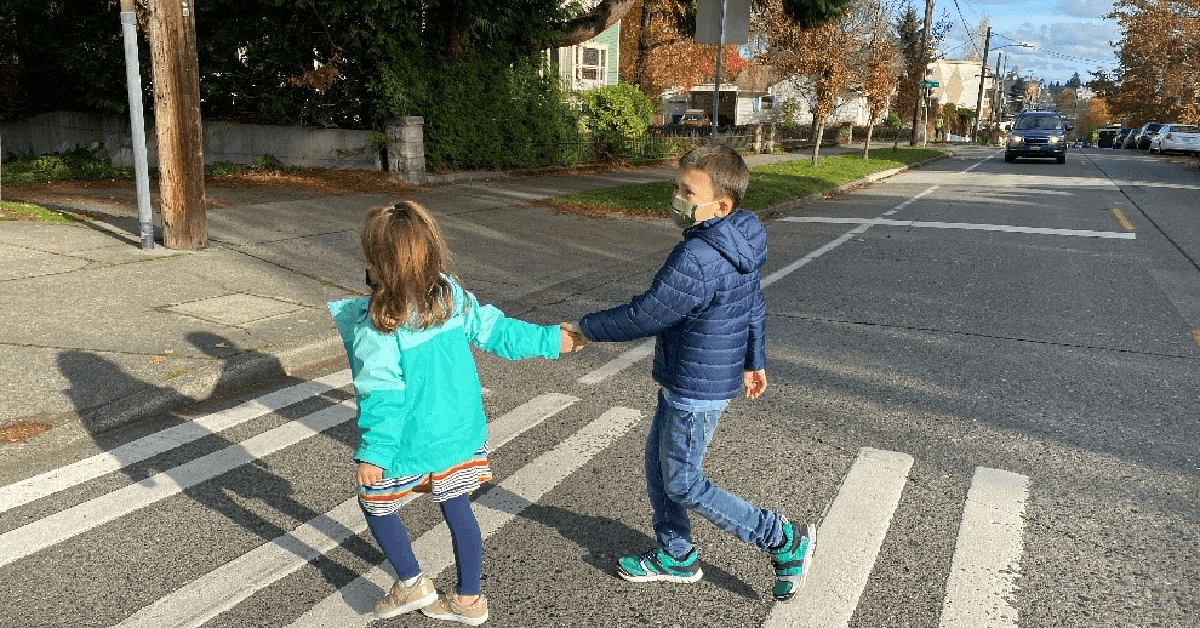
We’re building a transportation network to support our Vision Zero goal of ending traffic deaths and serious injuries on city streets.
We worked hard throughout the past year to deliver on our commitments to make Seattle streets safer. We’ve now lowered speed limits on 72% of Seattle’s major streets to 25 mph or less, which has proven to lower crashes and save lives. We’ve also added pedestrian-first walk signals to 30% of our signalized intersections and have implemented improvements along Rainier Ave S, Seattle’s most crash prone, high-injury street. These significant accomplishments support Seattle’s Vision Zero goal to end traffic deaths and serious injuries on city streets, but we acknowledge there’s more work to be done. 2020 provided many opportunities for us to rethink what community safety looks like and examine new ways we can contribute to making Seattle safe for everyone, especially our Black, Indigenous, and People of Color (BIPOC) community members.
We’ve updated our traffic signal policy to put the safety of people walking and rolling first.
Over the last few years, we’ve made improvements to our traffic signals and crosswalks to help achieve our goal of becoming America’s most walkable city. Building on this progress, we’ve been working to codify and update our traffic signal policy, with guidance from the Policy and Operations Advisory Group. This policy update will give people more time to cross the street safely, reduce pedestrian wait times at signals, and create more automatic walk signals so people don’t have to press a button.
Our new Modal Integration Policy Framework addresses needs across all travel modes where street space is in high demand.
Streets are fundamental to Seattle’s quality of life. They define how we move, connect people and places, give us access to important destinations, frame our urban landscapes and greenery, and ultimately enable vibrant public life to unfold. It’s part of our job to make sure streets work well for everyone. How do we understand and analyze tradeoffs when the right-of-way is not wide enough to meet the needs of each travel mode? Our new Modal Integration Policy Framework will help us plan and design streets so they work well for all modes and best align with Seattle’s values and goals.